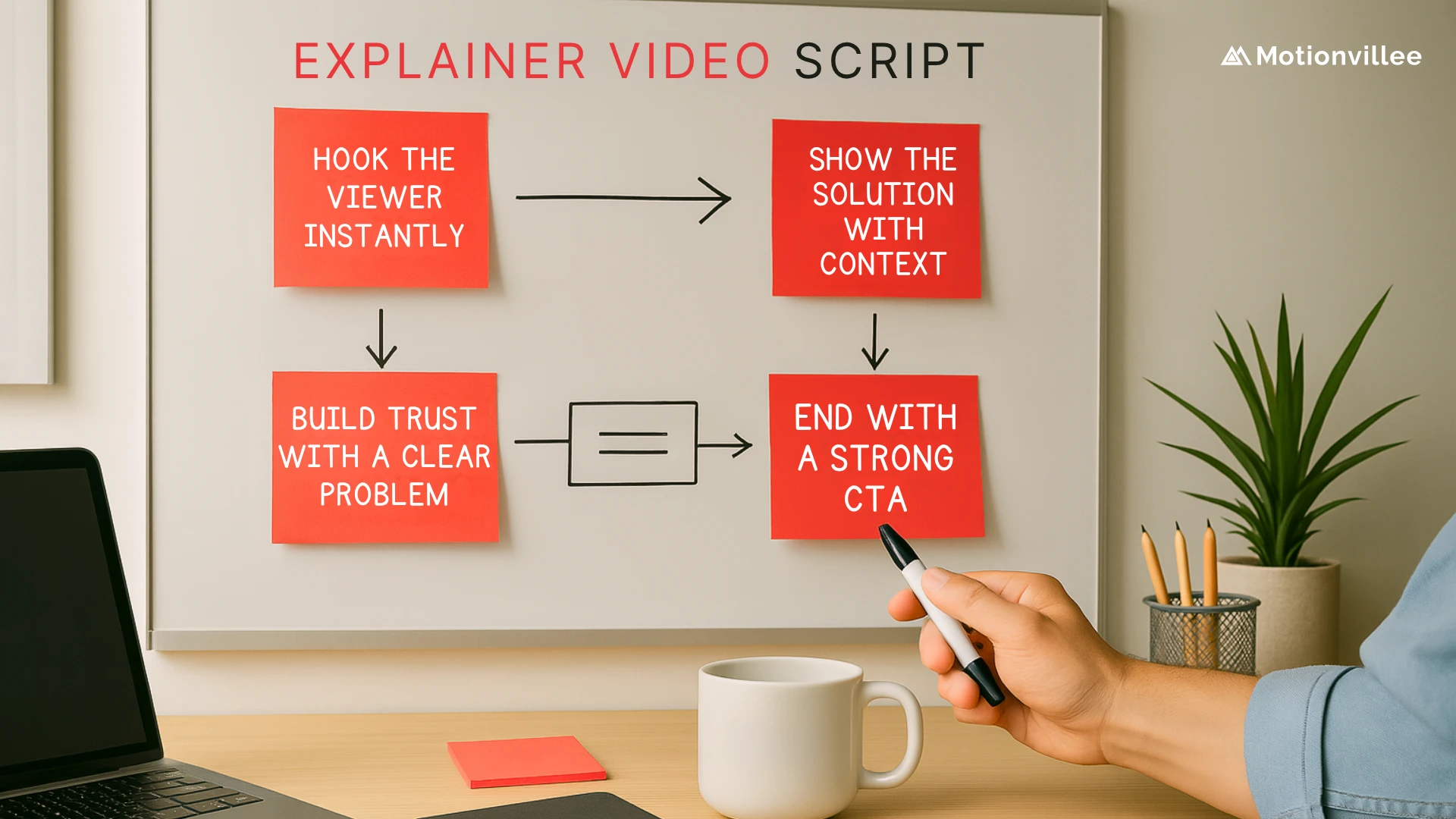A well-written explainer video script is the foundation of any high-performing video. Yet most scripts fall short because they try to explain everything at once, leaving the viewer overwhelmed or confused.
The real secret to an effective video is not flashy animation or voiceover tone. It is a clear, simple explainer video script structure that guides the viewer from problem to solution to action.
Whether you are creating your first video or updating a stale one, structure helps you:
- Stay focused on the core message
- Keep the video short and purposeful
- Align content with what the viewer actually needs to hear
In this blog, we will walk through 4 building blocks that make explainer scripts work, without guesswork or filler.
If you are involved in explainer video production for SaaS, B2B, or tech, these principles will help you get more from your next script.
Block 1: Hook the Viewer Instantly
The first few seconds of your explainer video are everything. If you do not grab the viewer’s attention right away, they will click away before your message even begins.
A strong hook sets the tone. It pulls the viewer in and makes them want to know what comes next.
Avoid:
- Slow intros
- Logo animations
- Generic phrases like “Welcome to our product”
Instead, start with something direct and relatable.
Here are simple ways to hook your audience:
- Ask a bold question
“Still using spreadsheets to manage leads?” - Call out a pain point
“You lose more customers in onboarding than you think” - Show a visual problem
A cluttered inbox, broken workflow, or error message
Keep your hook short. Aim to get into the problem within the first 5 seconds.
Remember, viewers are not waiting to be impressed. They are waiting to feel understood.
A sharp opening earns the right to explain what you do next. Without it, even the best script will go unnoticed.
Block 2: Present the Problem Clearly
Once you’ve hooked the viewer, the next step in your explainer video script is to show them that you understand their problem. This builds trust and keeps them watching.
The key is to describe the challenge in a way that feels real, not scripted or generic.
Here’s how to do it:
- Use the language your audience actually uses
- Focus on a common frustration or bottleneck
- Avoid overexplaining or diving into product details too soon
- Keep it short, ideally under 20 seconds
Examples of clear problem statements:
- “Teams waste hours switching between five different tools”
- “Your customers drop off before they even activate their account”
- “You’re not sure if your data is secure or scattered”
Many SaaS videos fail here by using vague claims like “we help businesses grow” or “we make work easier.” Be specific about the pain your viewer feels every day.
If you’re thinking about how to write explainer video script content that works, always start with empathy. When the viewer feels seen, they’re more open to what comes next, your solution.
Block 3: Show the Solution with Context
Once the viewer relates to the problem, they are ready for the solution. But how you introduce your product matters.
In a strong explainer video script, the product should feel like the natural next step, not a sales pitch.
Avoid listing features too early. Instead, focus on what the product helps the user achieve.
Here’s how to show your solution with context:
- Introduce the product with a clear purpose
“That’s where [Product Name] comes in” - Use benefits, not specs
“Automate follow-ups so no lead slips through” - Talk about real outcomes
“Teams save 10+ hours a week and close deals faster” - Use simple scenarios
“Sarah logs in, assigns tasks, and tracks progress, all in one view”
If your solution can solve multiple problems, focus on one clear use case in the video. You can always create other versions for different segments.
The goal here is to make the viewer think, that’s exactly what I need.
Block 4: End with a Strong CTA
A well-structured explainer video script should always end with a clear next step. This is where you guide the viewer on what to do, not just leave them with a logo or tagline.
The call to action (CTA) should be:
- Direct
- Relevant to the viewer’s stage in the funnel
- Easy to act on
Good CTAs avoid generic lines like “learn more.” Instead, they focus on one action the viewer can take right now.
Here are a few examples:
- “Start your free trial”
- “Book a demo today”
- “Download the full checklist”
You can also add value or urgency if it fits the context. Something as simple as “Get your free onboarding guide” can make a difference.
If you’re reviewing your explainer video production process, the CTA is where many scripts fall short. A strong close keeps momentum going and turns interest into action.
This principle applies across industries. Whether you’re planning SaaS or B2B video production, a focused CTA is always essential.
What to Do Next: Write Smarter, Convert Better
If your explainer video is not converting, chances are the problem starts with the script.
Let’s recap the 4 essential building blocks:
- Hook fast so viewers keep watching
- Present the problem in their words
- Show the solution with real-world context
- End with a clear CTA that drives action
These are simple ideas, but they make a big impact when done well. Whether you’re planning a new video or revisiting an old one, use this framework as a checklist.
If your current script feels bloated, vague, or too product-heavy, it might be time to rethink it.
Want a second pair of eyes on your messaging? Or need help turning your product value into a story that converts?
Get in touch with Motionvillee. We can help you plan, write, and produce explainer videos that actually work.







